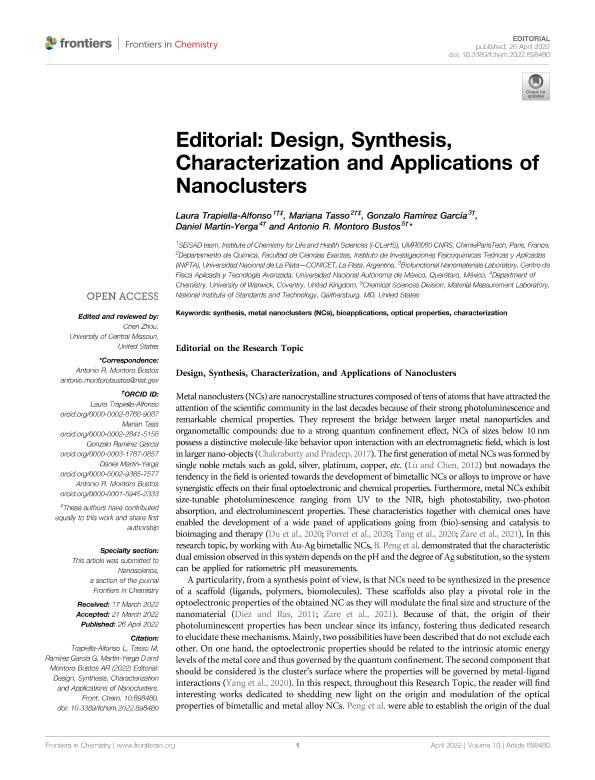Mostrar el registro sencillo del ítem
dc.contributor.author
Trapiella Alfonso, Laura
dc.contributor.author
Tasso, Mariana Patricia

dc.contributor.author
Ramírez García, Gonzalo
dc.contributor.author
Martín Yerga, Daniel
dc.contributor.author
Montoro Bustos, Antonio R.
dc.date.available
2023-07-19T19:33:01Z
dc.date.issued
2022-04
dc.identifier.citation
Trapiella Alfonso, Laura; Tasso, Mariana Patricia; Ramírez García, Gonzalo; Martín Yerga, Daniel; Montoro Bustos, Antonio R.; Editorial: Design, Synthesis, Characterization and Applications of Nanoclusters; Frontiers Media; Frontiers in Chemistry; 10; 4-2022; 1-2; 898480
dc.identifier.uri
http://hdl.handle.net/11336/204520
dc.description.abstract
We are witnessing the nanotechnology revolution brought about by the exponential growth of nanomaterial applications. Atomically precise nanoclusters are a unique class of materials in the ultrasmall size regime (1-3 nm in diameter), consisting of several to a few hundred atoms. Due to their ultrasmall size, nanoclusters exhibit exceptional physical and chemical molecule-like properties that are fundamentally different from their larger nanoparticle counterparts. Their mechanical, optical, electronic, magnetic, catalytic, electrochemical, and biological features can be easily tailored by controlling different factors, including their size, morphology, chemical composition, and surface structural characteristics. Particularly, recent advances and innovative uses of nanoclusters are growing rapidly in a wide variety of important sectors including medicine, industry, food, energy, toxicology, health care, electronics, transportation, information storage, physical infrastructure, consumer products, and the environment.The goal of this Research Topic is to host a diverse collection of significant contributions focused on current developments on the design, synthesis, characterization, and applications of nanoclusters. Despite the tremendous impact in the past decade of the technological advances associated with nanoclusters on research, industry, and society, important challenges and limitations remain in the understanding and the control of their physicochemical properties as well as in adapting existing analytical methodologies from the macro- to the nanoworld.This Research Topic will focus on how recent progress can overcome current drawbacks of some features of nanoclusters, such as low stability, biocompatibility, and high toxicity, that clearly impact their applicability. It will additionally highlight recent developments to surmount the limitations of existing analytical methodologies for their design, and synthesis, with a special focus towards metrological characterization. This Research Topic will hopefully inspire further research in the creation of next-generation nanoclusters with improved physicochemical properties such as supported metal nanoclusters and one-, two-, and three-dimensional self-assembly nanoclusters and give insight into developing innovative orthogonal and miniaturized analytical approaches for ultrasmall nanoscale characterization.The current Research Topic aims to cover promising, recent, and novel research developments in design, synthesis, characterization, and applications of nanoclusters. We welcome submissions of Original Research, Review, Mini Review, Perspective, Short Communications, and Methods articles, on themes including, but not limited to:• Novel strategies for the rational design, synthesis, and functionalization of nanoclusters for improved physical and chemical properties and enhanced applications.• Advances in microfluidics and microdevices for the synthesis, characterization, and applications of nanoclusters.• Structure-function effects: understanding the role of size, morphology, and composition on the chemical and electrochemical behaviour of nanoclusters.• Innovative separation techniques, miniaturized and orthogonal approaches for the characterization of nanoclusters.• Development of innovative metrological and statistical approaches for the analysis and characterization at the ultrasmall nanoscale.• Nanoclusters for diagnosis and therapy.• Applications of nanoclusters in electrochemical sensing, electrocatalysis, energy conversion and storage.• Supported metal nanoclusters and one-, two-, and three-dimensional self-assembly nanoclusters: from fundamentals to applications.
dc.format
application/pdf
dc.language.iso
eng
dc.publisher
Frontiers Media

dc.rights
info:eu-repo/semantics/openAccess
dc.rights.uri
https://creativecommons.org/licenses/by/2.5/ar/
dc.subject
BIOAPPLICATIONS
dc.subject
CHARACTERIZATION
dc.subject
METAL NANOCLUSTERS (NCS)
dc.subject
OPTICAL PROPERTIES
dc.subject
SYNTHESIS
dc.subject.classification
Nano-materiales

dc.subject.classification
Nanotecnología

dc.subject.classification
INGENIERÍAS Y TECNOLOGÍAS

dc.title
Editorial: Design, Synthesis, Characterization and Applications of Nanoclusters
dc.type
info:eu-repo/semantics/article
dc.type
info:ar-repo/semantics/artículo
dc.type
info:eu-repo/semantics/publishedVersion
dc.date.updated
2023-07-05T12:15:27Z
dc.identifier.eissn
2296-2646
dc.journal.volume
10
dc.journal.pagination
1-2; 898480
dc.journal.pais
Suiza

dc.description.fil
Fil: Trapiella Alfonso, Laura. Centre National de la Recherche Scientifique; Francia
dc.description.fil
Fil: Tasso, Mariana Patricia. Universidad Nacional de La Plata. Facultad de Ciencias Exactas; Argentina
dc.description.fil
Fil: Ramírez García, Gonzalo. Universidad Nacional Autónoma de México; México
dc.description.fil
Fil: Martín Yerga, Daniel. University of Warwick; Reino Unido
dc.description.fil
Fil: Montoro Bustos, Antonio R.. National Institute of Standards and Technology; Estados Unidos
dc.journal.title
Frontiers in Chemistry
dc.relation.alternativeid
info:eu-repo/semantics/altIdentifier/doi/http://dx.doi.org/10.3389/fchem.2022.898480
dc.relation.alternativeid
info:eu-repo/semantics/altIdentifier/url/https://www.frontiersin.org/articles/10.3389/fchem.2022.898480/full
Archivos asociados
